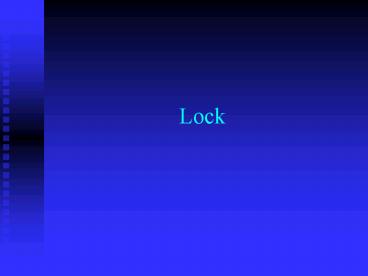Lock - PowerPoint PPT Presentation
1 / 17
Title:
Lock
Description:
This spectrometer is typically tuned to the deuterium NMR resonance frequency. ... On most NMR spectrometers the deuterium lock serves a second function. ... – PowerPoint PPT presentation
Number of Views:55
Avg rating:3.0/5.0
Title: Lock
1
Lock
2
Prinzipielle Schritte zur Messung
- Lock
- Shimming
- Acquisition
3
LOCK-System
- wozu?
- das Magnetfeld ist zeitlich nicht immer gleich
das Lock-System gleicht Schwankungen aus indem es
die Frequenz konstant hält - Frequenz kommt von Deuterium aus dem
Lösungsmittel - Locksignal als Dispersionssignal
4
LOCK-System
Wie sieht ein Spektrum OHNE LOCK aus?
5
LOCK-System
Was passiert mit dem Magnetfeld Bo?
6
Lock System
Absorption Mode
Dispersion Mode
sind um 90 PHASENverschoben
Dispersion Mode wird für Lock Signal verwendet,
da dabei der Nullpunkt leichter konstant gehalten
werden kann
7
LOCK-System
- ist eigentlich ein Deuterium-Spektrometer
- Lockpower so wie TPWR bei 1H oder X
- Lock Gain so wie Receiver Gain (gain)
- Lock Phase
- Relaxation Zeiten für verschiedene LM sehr
unterschiedlich (vor allem für Shim) - Sättigung des Signals
8
Lock
Command window
Spectrum window
Parameter window
9
Lock
Click auf ACQI-button öffnet dieses Fenster
10
Lock
Probe ist hier bereits gelockt Lock
level31.7 kann durch lockpower, lockgain und
lock phase verändert werden
11
Lock
Hier wurde lockgain um 10 dB erhöht der Lock
level ist jetzt 100.1
12
Lock-System
- geht auch automatisch durch Eingabe von LOCK
- was passiert dabei?
- Einstellung der Frequenz für das LM optimieren
von lock power, lock gain und lock phase so daß
keine Sättigung auftritt.
13
Lock
- SU setup nach Laden von Shim-Parametern etc.
erst dann werden die Daten am Board aktualisiert
z.B. auch Temperatureinheit - Flags IN (interlock) wenn INY und der Lock
geht verloren stop der Acquisition ALOCK
Autolock wenn ALOCKY lock bei jeder Messung
wenn ALOCKS lock bei jedem neuem Sample wenn
ALOCKN kein Autolock wird vor allem für
Autorun benötigt
14
Spektrometer Schema
15
Spektrometer Schema
16
LOCK-System
- In order to produce a high resolution NMR
spectrum of a sample, especially one which
requires signal averaging or phase cycling, you
need to have a temporally constant and spatially
homogeneous magnetic field. The field strength
might vary over time due to aging of the magnet,
movement of metal objects near the magnet, and
temperature fluctuations. - The field lock is a separate NMR spectrometer
within your spectrometer. This spectrometer is
typically tuned to the deuterium NMR resonance
frequency. - It constantly monitors the resonance frequency of
the deuterium signal and makes minor changes in
the Bo magnetic field to keep the resonance
frequency constant. The deuterium signal comes
from the deuterium solvent used to prepare the
sample.
17
LOCK-System
- On most NMR spectrometers the deuterium lock
serves a second function. It provides the ?0
reference. The resonance frequency of the
deuterium signal in many lock solvents is well
known. Therefore the difference in resonance
frequency of the lock solvent and TMS is also
known. As a consequence, TMS does not need to be
added to the sample to set ?0 the spectrometer
can use the lock frequency to calculate ?0.































